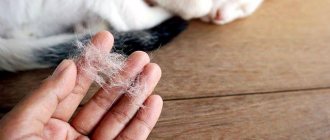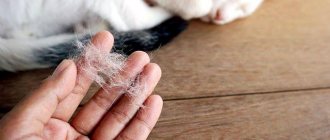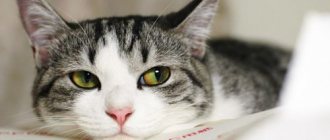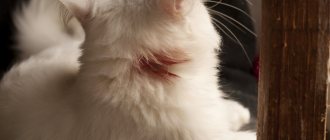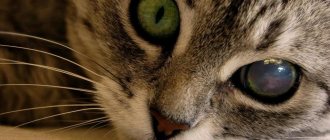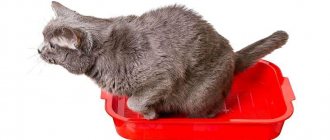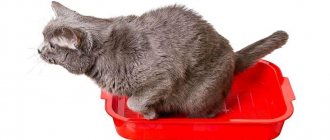Frequent cleaning is the least of the problems that arise when pets experience excessive hair loss. The causes of hair loss in cats are not always natural - sometimes the situation can be explained by a pathology that requires mandatory treatment. Owners can make a presumptive diagnosis based on accompanying symptoms. If you suspect skin or other diseases, you will need to contact a veterinarian.
Natural causes
Minor hair loss occurs when hair follicles die. Their life cycle consists of 3 phases:
- anagen
– the longest and most active growth phase;
- catagen
– regression phase, accompanied by the cessation of further growth;
- telogen
– a resting phase, which involves the separation and removal of the hair follicle to the surface of the skin.
Other natural causes of hair loss in cats depend on the time of year, quality of diet, stress level, age and physiological characteristics. If the coat does not undergo major changes, and the pet’s health remains satisfactory, then nothing threatens its life and health.
Shedding in season
Seasonal molting in adult animals occurs twice a year: in autumn and spring. Before winter, the undercoat is renewed and becomes thicker to protect the cat from the upcoming frosts. By spring, it begins to fall out again, but this time it thins out, returning to its original state.
Long-haired pets may shed more heavily. These cats lose their hair in small clumps.
An abundance of dead hair can lead to excessive accumulation of hairballs in the stomach and intestines. These days, give your mustachioed pet pastes that stimulate hair removal, or feed it grass. Also, do not forget about regular brushing and add more vitamins to the diet, but only after consulting a veterinarian.
Inappropriate diet
When feeding cheap food or an unbalanced natural diet, hair loss can lead to the formation of bald patches. This occurs due to a lack of vitamins responsible for the quality of the coat.
Experiences and stress
Under severe stress, a mustachioed pet often falls into apathy and refuses to eat. Abnormal bowel movements and vomiting are also possible. To understand the root cause, try to analyze recent events. Most often, animals worry because of a change in environment, the appearance of new family members and insufficient attention from the owner.
Elderly age
Older animals become bald around the face and ears. After 8 years, all metabolic processes slow down. The period of hair growth is also reduced - this is natural and does not require drug treatment. If the skin loses its shine, you can take vitamins.
Pregnancy and lactation
Pregnant cats are not much different from people: first they bloom, and then they give all their strength to the new generation. At first, the cat's hair falls out on its stomach near the nipples. This makes it easier to access the source of milk when feeding. A more abundant loss occurs immediately after childbirth and lasts until the end of lactation. After this, the pet’s condition stabilizes.
Correcting the situation
Solving this problem is quite simple: it is necessary to adjust the pet’s diet in accordance with its needs, and replace low-quality food with healthier ones.
There are situations where hair begins to fall out even when the cat eats a high-quality product. This may be due to individual intolerance to a certain food. In this case, you just need to replace it with another one. Its class should be the same, but the composition is different or even a completely different manufacturer.
Skin diseases
If a cat develops sores on its skin and hair falls out in clumps, there is a high probability of pathology. In most cases, dermatological diseases are accompanied by severe itching and suppuration in the areas of scratching.
Ringworm and other fungus
Dermatophytosis, or infectious skin diseases caused by fungi, is contagious to humans. Infection with lichen is accompanied by itching, deformation of the claws, redness and peeling of the skin. The main symptom of this pathology is the focal formation of bald spots, which over time merge into more extensive lesions.
Malfunctions of the endocrine system
Hormonal disturbances not associated with postpartum activity may indicate disturbances in the endocrine system. Most often this occurs after taking hormonal drugs that suppress sexual desire. Another characteristic symptom, in addition to constant itching, is symmetrical hair loss on both sides of the body.
Folliculitis
Folliculitis is an inflammation of the hair follicle caused by poor animal care. Small ulcers with yellowish-green contents appear at the base of the hairs. Most often they appear on the neck or face, causing severe itching. When an abscess ruptures, pathogenic microorganisms quickly penetrate into it, causing a secondary infection.
The occurrence of dandruff
The cause of baldness in cats can be dandruff, that is, a dry form of seborrhea. It occurs when sebum production is reduced, disrupting the skin's natural exfoliation cycle. In addition to dandruff, dry seborrhea is accompanied by itching, an unpleasant odor, thinning and excessive loss of hair follicles. Most often, this condition is explained by a decrease in immunity, but sometimes the root cause lies in flea or tick infestation.
Tick or flea infestation
Infection with ectoparasites, which inject foreign protein during feeding, is always accompanied by itching. The animal itches constantly, gnawing into the affected areas and biting off pieces of fur. Scratching can lead to a secondary infection in the wounds. Suppuration begins.
The location of the lesion depends on the type of parasite. They can live on the back, paws or tail. Some mites (especially scabies) dig their tunnels right under the eyes of the unfortunate pet. Due to unbearable itching, the cat becomes apathetic and irritable. He sleeps poorly and refuses to eat. His weight is dropping and his condition continues to deteriorate. Dandruff appears on bald areas.
Oncology
The body spends all its strength to fight malignant neoplasms. There are simply no resources left to nourish the hair follicles. If your pet is constantly thirsty, suddenly loses weight, suffers from bloating, upset stools and bouts of bloody vomiting - do not hesitate and immediately sign up for a diagnosis. Oncology detected in the early stages is treatable.
Alopecia
Alopecia is one of the types of hair loss. It can be caused by all sorted reasons, suggesting the appearance of partially or completely bald areas on the body. If the loss of hairs is not frightening (molting), then it is not classified as alopecia.
Hypotrichosis
With this genetic anomaly, the kitten's fur disappears in the first months of life or is absent at birth. This alopecia is not always generalized - some areas of the skin may retain hair. Bald areas become darker and often suffer from seborrhea.
Due to its peculiarity, the baby remains forever vulnerable to direct sunlight and severe frost. As he grows older, his skin becomes rougher and less vulnerable, but the increased risk of burns and frostbite remains.
Solar dermatosis
Solar dermatosis is an inflammatory disease that develops with high sensitivity to ultraviolet radiation. The pathology occurs in pets with a white coat that are devoid of melamine. This pigment is not only responsible for color, but also provides sun protection.
When exposed to sunlight, the animal's skin turns red and hair falls out. The affected areas begin to peel off and itching appears. Despite the absence of pain, irritation is difficult to miss. Without treatment, ulcers appear in its place. Increases the likelihood of developing skin cancer.
Baldness at the injection site
Baldness is one of the side effects of subcutaneous injection of certain drugs. In most cases, the injection site is quickly restored. If the bald spot persists for too long after vaccination or antibiotic therapy, consult your veterinarian.
Hormonal disbalance
This situation most often occurs due to the use of hormonal drugs, such as drops or tablets, which reduce the animal’s sex drive. Thanks to these means, the pet stops marking its territory and demanding a partner. However, such violent interference with hormonal levels does not pass without leaving a trace. If, after using such drugs, a cat’s hair falls out in clumps to the point of bald spots, the cat becomes lethargic, indifferent, eats poorly, and begins to see or hear worse, in most cases this indicates that a hormonal imbalance has occurred. This problem should be solved by a veterinarian by prescribing corrective therapy. Timely sterilization or castration allows you to avoid such problems.
Other diseases
Veterinarians include helminthiasis, allergic reactions, autoimmune pathologies and dysfunction of internal organs as other causes of receding hairline and bald spots. Hair loss is just the least of the problems. In some cases, an animal left without treatment may die.
Infection with worms
The waste products of worms lead to severe intoxication of the body and gradual failure of internal organs. An infected animal loses its appetite, vomiting and diarrhea. His fur is thinning and dull. Despite the dramatic weight loss, the belly remains round and firm.
Allergy
Allergies can be food or non-food. Detecting the allergen on your own is problematic, so treatment is often prescribed before the pathogen is identified.
In addition to alopecia, an allergic reaction from the skin may be accompanied by severe itching. Scratching can cause the damaged areas to become red, flaky, and blistered or eczema-like. Tearfulness, rhinitis and gastrointestinal disorders may occur.
Autoimmune diseases
Autoimmune (focal) alopecia is a malfunction of the body. Immune cells begin to produce antibodies to destroy their own cells, mistaking them for foreign ones. Hair follicles are affected. Antibodies not only destroy existing hairs, but also prevent the formation of new ones. Bald areas are no longer restored.
This disease, like all immune pathologies, is very rare. Areas affected by alopecia grow over time. Without timely treatment, the condition of the coat will only worsen. The sides, groin and thighs of the animal are primarily affected.
Hyperthyroidism
Hyperthyroidism is a pathology of the thyroid gland that disrupts the natural amount of hormones produced. Due to increased levels of hormones, the cat develops seborrhea. He constantly licks himself, and when he is stroked, tufts of fur remain on his hands.
Hyperthyroidism is a secondary disease. It occurs with pathologies of the liver and kidneys, disorders in the gastrointestinal tract and immune system. In addition to alopecia, symptoms may include diarrhea, vomiting, loss of appetite, increased urination and weight loss.
Allergy
In most cases, as in humans, an allergic reaction in an animal manifests itself on the skin. The hair falls out symmetrically in parallel, redness appears on the skin, and the ears become inflamed and itchy. Most often, allergies are caused by some food product, including feed. In such cases, the diet is simply adjusted.
But the problem may not always be food. Allergies can occur to grooming products or to the material from which the bedding or bowl is made. If the allergy is not related to food, you need to temporarily limit the animal from all its things. After the allergy has stopped, you should return one item at a time and carefully observe, after which the allergic reaction will appear again. Accordingly, this item will subsequently need to be removed from the cat’s everyday life.
Hair loss in kittens
The kitten's body is especially sensitive. The appearance of alopecia can be caused by infection, too early birth, or a small amount of vitamins in the diet.
In addition to hypotrichosis, kittens often suffer from adenitis of the sebaceous glands. Sick pets have bald heads, ears and necks. Bald areas take the shape of a circle. Damaged skin peels and smells unpleasant. If left untreated, bald patches spread to the back and base of the ponytail. Inflamed glands cause severe itching, so your pet is constantly itching. The exfoliated scales become moist and acquire a yellow or gray tint.
Pooh-eaters
These parasites are also called lice eaters. Their food consists of particles of animal hair and skin. They are very difficult to spot as they are much smaller than fleas. Therefore, you can understand that a pet has acquired them only by the symptoms: the pet is nervous, sleeps poorly, bites its fur coat, stops listening, itches endlessly and loses its fur. If such signs occur, it is necessary to point the lamp at the animal and wait 10 minutes. If these parasites are present on the pet’s body, they will definitely come out closer to the warmth. And then it will be possible to see exactly why the cat’s clumps of hair fall out.
How to carry out treatment?
If your cat's fur is falling out in clumps, ask your veterinarian what to do.
To make a diagnosis, laboratory and instrumental studies are used:
- blood analysis;
- skin scraping;
- use of Wood's lamp;
- hair examination;
- Ultrasound;
- X-ray.
Depending on the identified cause, the mustachioed patient is prescribed surgical or drug therapy. In case of hormonal imbalances, castration is performed, and if oncology is detected, the tumor is excised.
Among the drugs used:
- sedatives that reduce stress levels;
- antibacterial and antifungal, fighting bacterial and fungal infections;
- antihistamines, which suppress the production of histamine during allergies;
- antiparasitic, destroying fleas, ticks and helminths;
- immunostimulants that stimulate the work of immune cells.
In addition to taking medications, antiseborrheic shampoos, ointments and antiseptics are prescribed to treat suppurations. If a food allergy is suspected, the animal is placed on a strict diet.
Fleas
The most common types of pests are fleas. These small, dark, shiny insects can be easily seen on your pet with the naked eye. They feed on blood. They bite through the skin in order to get to food. After such a meal, the bite site begins to itch, which causes a lot of anxiety to the animal. Starting to scratch itself, the cat tries to relieve the itching.
If fleas are found, you must get rid of them immediately, as they multiply very quickly.
Hypotrichosis
This is a hereditary pathology of kittens, which looks like a hair anomaly - loss of hair (complete or partial), and then growth of it again. Kittens may be born without hair, whiskers, claws, or tongue papillae.
Adult cats often have a complete absence of hair in some areas of the body or the appearance of fluff. A detailed examination of bald spots can reveal altered hair follicles or their complete absence.
Hypotrichosis is not a disease, but a genetic disorder that cannot be treated. It is recommended to castrate animals with this developmental feature.
Breeds prone to this pathology in genotype:
- Burmese (or sacred Burma);
- Burmese (or Burmese);
- Devon Rex;
- Siamese
Ringworm
Contrary to its name, ringworm is not a worm. It is actually an itchy fungal infection that lives in the hair follicles and feeds on dead cells. When the fungus colonizes the hair shafts, the hair shafts break off at skin level and leave bald patches. Sometimes hard spots form around the ears and other affected areas. Ringworm is highly contagious and can be diagnosed by culturing the hair for the fungus. There are a number of possible treatments to eliminate the infection.
This includes:
- Application of a course of lime-sulfur drops
- Prescribing griseofulvin tablets on the recommendation of a veterinarian
- Applying a topical ointment such as itraconazole.
- Repeated antifungal shampoos
- Completely shave the entire cat
Alopecia associated with cat breed
Today, hairless cats and half-naked breeds are very popular. These include:
- sphinxes;
- rexes;
- Devon Rex;
- lykoy.
However, when breeding these cats, the following problems arise:
- In sphinxes, individual hairs can appear in the form of twisted thin rods; it is difficult for them to break through the thickness of the skin. As a result, nodules develop that turn into comedones.
- In semi-hairless breeds, the coat may grow and shed unevenly, which is considered normal.
- Likoy cats have no hair on their faces in places - this is a breed standard that must be taken into account.
- In blue and beige rexes, hypotrichosis may occur at a young age due to pigmentation problems (breeding defects).
- The birth of hairless kittens in woolly cat breeds as a result of a spontaneous mutation.
The cat's stomach, hind legs, and withers are bald: what to do, how to treat it?
If a pet has health problems, it is always a worry for the owners. After all, you want to help the animal as quickly as possible. So, the cat has a bald stomach, hind legs, and withers - what to do, how to treat it? First you need to determine the cause of the disease and eliminate it:
- Check your cat's diet . Choose hypoallergenic quality food. With the right diet, you don’t even have to look for additional sources of vitamins.
- Improve the animal's living conditions . Move his bed away from the radiator and humidify the air.
- Use parasite killers . For example, Spot-on or IN-AP .
- If you are sure that the cause is an allergic reaction , tell your veterinarian.
- If the cause is stress , use sedatives, for example, Stop-Stress or Vetspokoin .
There are special vitamins for cats against hair loss. For example, brewer's yeast helps a lot. But you should not self-medicate. Be sure to visit a veterinarian. Only he will be able to establish an accurate diagnosis and choose a method of treating the animal.
Prevention measures
To avoid hair problems, you need to follow these recommendations:
- choose high-quality food that matches the condition and age of the cat;
Give your pet antihelminthics at intervals of three months;- regularly treat the animal for fleas;
- eliminate all factors that can lead to the development of allergies;
- vaccinate in a timely manner;
- provide your pet with complete care.
Symptoms You Shouldn't Ignore
If the animal notices the appearance of completely bare areas of the skin or is covered with excessively sparse hair, then it is necessary to consult a doctor. Also of concern are peeling, redness, itching and crusting.
All these symptoms cannot be ignored: there is a high probability that your pet is developing a serious illness.
